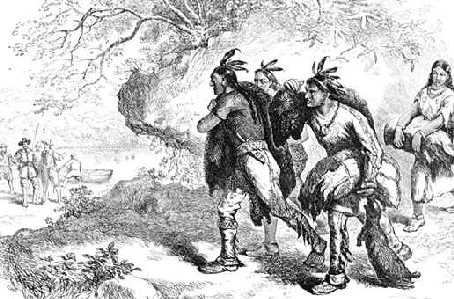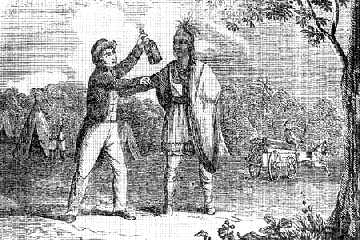 |
Fur Trader
![]()
The Fur Trade in North America began with the earliest contacts between the Iroquois and Europeans. Within a few years of their arrival in North America, French, English, and Dutch fur traders were bartering with the Iroquois throughout the Mohawk Valley. In Europe there was a good market for furs, while in North America there were seemingly unlimited supplies of fur-bearing animals, especially beaver.
Fur traders offered the Iroquois trade goods which included iron tomahawks, knives, axes, awls, fish hooks, cloth of various colors, woolen blankets, linen shirts, brass kettles, silver jewelry, assorted glass beads, guns and powder. They also brought rum and brandy. The Iroquois were eager to have these goods and they paid for them with furs. While the beaver pelt was always the foundation of the trade, the Iroquois also harvested otter, mink, fox, bear and deer.
In time, the Iroquois became so dependent on traders that they gave up more and more of their own culture. The imported goods of Europe replaced the things the Indians had formerly made for themselves using the resources available in their environment.
To understand the relative value of furs and trade goods, refer to this table developed using data from 1790. The information for this table comes from the Ohio History Society <http://www.ohiokids.org/ohc/history/h_indian/tribes/iroquois.html>
|
Trade
Goods
|
Iroquois
Goods
|
| 3 nest copper kettles -- 7 cts | raccoons --from 37 1/2 to 40 cts. each |
| in a
nest with covers wt. 100 lbs. 90 cts. per lb. |
foxes, cats, and fishers-- from 50 to 67 cts. each |
| 1 nest contg. 12 copper kettles without covers wt. 100 1/2 lb -- 80 cts. a set | minks -- 50 cts. each |
| 38 rifles
-- $12.50 each |
musk rats grown ones-- 25 cts. each |
| 2 casks
powder 185 lb. b.b. patent Shot -- $14.50 100 wt. |
otters -- $4 to 5 each |
| 760 pair ear bobs ca. -- $12.50 per 100 pair | bears- grown ones--$5 |
| 16 pair fluted wrist bands wt. 14 oz 2 dwts. ca-- $1.60 per oz. | beavers-- 125 cts. |
| 6 gorgets $18.36 per doz. | buck skins always -- 100 cts. |
| 18 beaver traps -- $2.25 | does skins -- 67 to 75 cts. each |
| 20 ditto (common) traps -- $3.00 | 77 dressd. does skins, buck & does -- 75 cts. each |
| 3 traps -- $1.67 | does-- 75 cts. each |
| 330 lb. pig tail tobacco -- $15 | 112 com. (common), moccasins--25 cts. each |
|
2 shot bags-- $1.25 a yd. yellow flannel-- 40 cts. a yd. |
13 fine ditto (common) (moccasins)-- 50 cts. each |
| 7 1/2" red ditto -- 41cts. | 43 lb. bees wax-- 12 1/2 cts. |
| 14" white ditto-- 41 cts. | 28 lb. deer tallow -- 9 cts. |
| 6" stroud cloth 96 1/2 cts. | 54 lb. indian sugar -- 10 cts. |
![]()
Alcohol and the Fur
Trade
There were other problems associated with the fur trade. While there were honest traders who dealt fairly with the Iroquois, too many greedy, unscrupulous men in the trade cheated and exploited them. Alcohol was an important and permanent part of the trade. It had devastating effects on many Indian tribes. Numerous witnesses have written of the violence and tragedy the liquor trade brought to the Indian villages.
The following quote comes from Ohio History Central. From the Ohio History Society <http://www.ohiokids.org/ohc/history/h_indian/tribes/iroquois.html>
"In a conference at Carlisle, Pennsylvania, on October 3, 1753, some members of the Iroquois Confederacy complained to a commission appointed to hear their grievances and to the Governor of Pennsylvania about the traders. The Iroquois Chief Scarrooyady said:
| Your Traders now bring scarce anything but Rum and Flour; they bring little powder and lead, or other valuable goods. The Rum ruins us. We beg you would prevent its coming such quantities by regulating the Traders. We never understood the Trade was to be for Whiskey and Flour. We desire it may be forbidden, and none sold in the Indian Country; but if the Indians will have any they may go among the inhabitants and deal with them for it. When these Whiskey Traders come, They bring thirty or forty kegs and put them down before us and make us drink, and get all the skins that should go to pay the debts we have contracted for goods bought of the Fair Traders; by this means we not only ruin ourselves but them too. These wicked Whiskey Sellers, when they have once got the Indians in liquor, make them sell their very clothes from their backs. In short, if this practice be continued, we must be inevitably ruined." |
![]()
Women in Fur Trade Society
Initially, women did not play an important role in the fur trade industry. But in time, women came to be an integral part of the work force of fur trade communities. Their activities included raising children, planting and harvesting crops, fishing, gathering and preserving food, gathering firewood, producing clothing (particularly moccasins and snowshoes), as well as a wide variety of daily, invaluable domestic tasks.
The primary method of introduction of women into the fur trade community was through marriage. Marriage "after the custom of the country" was an indigenous marriage rite, which evolved to meet the needs of fur-trade society.
The marriages of European men and Native women were encouraged by Iroquois leaders, as a way to create a social bond reinforcing the economic relationship between the two groups.
Home Page | Assessment
| Lesson 1 | Lesson
2 | Lesson 3 | Lesson
4 | Frontier
Characters
Learning Aids | Great
Law of Peace | US Constitution | Timeline
| Works Cited
© 1 October 2001, Portland State University